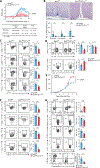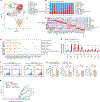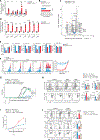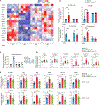Tim-3 adapter protein Bat3 acts as an endogenous regulator of tolerogenic dendritic cell function
- PMID: 35275752
- PMCID: PMC9273260
- DOI: 10.1126/sciimmunol.abm0631
Tim-3 adapter protein Bat3 acts as an endogenous regulator of tolerogenic dendritic cell function
Abstract
Dendritic cells (DCs) sense environmental cues and adopt either an immune-stimulatory or regulatory phenotype, thereby fine-tuning immune responses. Identifying endogenous regulators that determine DC function can thus inform the development of therapeutic strategies for modulating the immune response in different disease contexts. Tim-3 plays an important role in regulating immune responses by inhibiting the activation status and the T cell priming ability of DC in the setting of cancer. Bat3 is an adaptor protein that binds to the tail of Tim-3; therefore, we studied its role in regulating the functional status of DCs. In murine models of autoimmunity (experimental autoimmune encephalomyelitis) and cancer (MC38-OVA-implanted tumor), lack of Bat3 expression in DCs alters the T cell compartment-it decreases TH1, TH17 and cytotoxic effector cells, increases regulatory T cells, and exhausted CD8+ tumor-infiltrating lymphocytes, resulting in the attenuation of autoimmunity and acceleration of tumor growth. We found that Bat3 expression levels were differentially regulated by activating versus inhibitory stimuli in DCs, indicating a role for Bat3 in the functional calibration of DC phenotypes. Mechanistically, loss of Bat3 in DCs led to hyperactive unfolded protein response and redirected acetyl-coenzyme A to increase cell intrinsic steroidogenesis. The enhanced steroidogenesis in Bat3-deficient DC suppressed T cell response in a paracrine manner. Our findings identified Bat3 as an endogenous regulator of DC function, which has implications for DC-based immunotherapies.
Conflict of interest statement
Figures







References
-
- Cabeza-Cabrerizo M, Cardoso A, Minutti CM, Pereira da Costa M, Reis E Sousa C, Dendritic cells revisited. Annu. Rev. Immunol 39, 131–166 (2021). - PubMed
-
- Benham H, Nel HJ, Law SC, Mehdi AM, Street S, Ramnoruth N, Pahau H, Lee BT, Ng J, Brunck ME, Hyde C, Trouw LA, Dudek NL, Purcell AW, O’Sullivan BJ, Connolly JE, Paul SK, Lê Cao KA, Thomas R, Citrullinated peptide dendritic cell immunotherapy in HLA risk genotype-positive rheumatoid arthritis patients. Sci. Transl. Med 7, 290ra287 (2015). - PubMed
Publication types
MeSH terms
Substances
Grants and funding
LinkOut - more resources
Full Text Sources
Molecular Biology Databases
Research Materials

